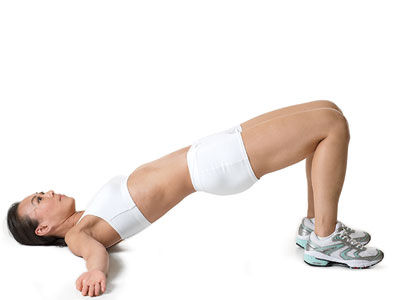The one glutes exercise that is underused by many is the hip extension. The hip joint extends through the synergistic working of the hamstrings, gluteal muscles and extensors, with support from the muscles of the lower back. If you keep the muscles of your posterior chain strong and active, you will not only get a great butt, but also improve your posture and avoid lower back pain, one of most common aches for sedentary workers.
Most people have poorly developed gluteal muscles and hamstrings, usually from sitting down too much and just not engaging in activity that emphasis those muscles. Both these muscle groups are used extensively in locomotion but they are especially called upon during athletic movements. Sprinting, ice skating, jumping, bounding, and rapidly changing direction, are all movements that rely on the strength of the hamstrings and the glutes.
As a plus for women, the glutes (the muscles of the butt) can be toned and developed to produce that sexy J-Lo shape. In short, for optimal functioning of the musculature system, work the muscles that produce hip extension.
The Hip Extension Progression
The exercise that works the hip extension better than any other is the Single Leg Hip Thrust, but to get there you’ll need to progress some simpler movements. Start with Glute Bridge and when you progress continue with more complicated variations.
Glute Bridge
Lie with your back on the floor and knees bent at 90 degrees. Lift the hips off the floor by pushing through the floor with your heels. The result should be a bridge from the back of your shoulders to your knees. Lower your hips and repeat.
Glute Bridge
Single Leg Glute Bridge March
A slightly harder version of the Glute Bridge is to hold the top of the bridge and raise each leg one after the other in a marching fashion. Hold each march for 3 seconds before changing legs.
Single Leg Glute Bridge March
Shoulder Elevated Hip Thrust
Find a bench (a bed works well) and rest your shoulder across the edge, feet on the floor. Allow your hips to sag until your butt almost touches the floor. Now perform the same hip raise movement as in the Glute Bridge. Hip Thrusts are more difficult than Bridges because they move the hips through a greater range of motion.
Shoulder Elevated Hip Thrust
Single Leg Glute Bridge
Perform the bridging movement with one leg off the floor so that the remaining leg has to produce the hip extension. This makes the exercise a lot tougher and the core and hips have to work hard to stabilise the torso throughout the movement.
Unilateral Glute Bridge
Hip Thrust March
In the Hip Thrust position (shoulders elevated, feet on the floor) hold the top position of the exercise and raise one leg at a time in marching style. Hold each march at the top for 3 seconds before raising the other leg.
Hip Thrust March
Single Leg Hip Thrust
Perform the Hip Thrust with one leg. Once you’ve completed all your reps on one leg, switch and complete the same number on the other leg.
Unilateral Hip Thrust
The Hip Thrust progression is sufficient for most people. If you are up for an even greater challenge, raise your feet on another bench of a similar height of your shoulders.
Single Leg Shoulder and Leg Elevated Hip Thrust
Work your butt off by sinking low and using one leg to raise your body up.
How to Introduce Hip Extensions Into Your Workouts
If you are mainly performing Squats for the lower body and neglecting hip extension exercises, add a few sets of one of the hip extension exercises above. Increasing the strength in hip extension will carry through to your Squats as well.
Whatever level of hip extension exercise you choose, at a minimum, perform 20-30 Glute Bridges before your leg workout. These will wake your glutes up from their slumber, making them more active in your Squats.
Start with one of the easier hip extension movements and perform a lot of reps initially. Again, 20-30 is a good number. Your initial goal should be to reinforce the movement pattern before really challenging your muscles with tougher versions of the exercise for lower reps.
Here is the complete group of hip extension exercises, progressing from easiest to the most difficult. Start at exercise one and work your way up.
[table]
| Easy | Average | Hard |
|
Glute Bridge 20-30 reps |
Shoulder Elevated Hip Thrust15-20 reps | Unilateral Glute Bridge 10-15 reps |
| Glute Bridge March 20-30 reps | Shoulder Elevated Hip Thrust March15-20 reps | Unilateral Shoulder Elevated Hip Thrust10-15 reps |
| Shoulder and Leg Elevated Hip Thrust10-15 reps | ||
| Unilateral Shoulder and Leg Elevated Hip Thrust10-15 reps |
Glute Bridges and Hip Thrusts are not the only exercises that work the hip extension but they work the posterior muscles safely and effectively, without weights.
Deadlifts and Kettlebell Swings also work hip extension but from a vertical position so if you’re really looking to get strong then you may want to put some weight on a bar and pick it up from time to time.
Certain types of cardio machines, such as the cross trainer, can also tone your glutes and hips and with low impact on your knees.
The single leg exercises are particularly good for your muscles and joints because the entire movement relies on one side of the body. This helps even out any imbalances that over time can end up as chronic injuries.
The point is, don’t neglect the muscles that line your posterior chain. They are vital for healthy movement, longevity, great posture, athleticism, and a pain-free back. Add them liberally to your workouts and marvel at how much better your body will perform not just in the gym, but also out in the real world.
